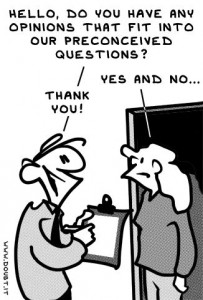
Q1: “What do you think of our awesome design team?”
Q2: “Have you quit smoking?”
Imagine asking the above questions in a market research survey. Can we expect to collect honest and reliable responses from our target audience? Supposedly, a reluctant Yes, No, Yes…..
The above survey questions fall in the category of leading questions and loaded questions. Usually, these biased survey questions compel the survey respondents to answer in a particular way on the basis of assumptions, fear factor, admission of guilt, and more.
Firstly, Q1 leads the survey respondent to give a positive answer with the use of the adjective “awesome”. A bias is being created in their minds that the design team is good and worthy of a positive survey rating.
Secondly, if the answer to the Q2 is “Yes”, it is assumed that the respondents had a past experience of smoking (even if they hadn’t ever smoked in reality). And, no one would be keen to answer “No”, which is an admission of having consumed alcohol in the past.
Hence, you need to be careful and avoid leading and loaded questions to collect reliable and accurate survey responses. In this blog, let’s understand the concept of leading and loaded questions in depth.
What is a Biased Survey?

Source: Climate Science: Roger Pielke Sr.
A biased survey is mostly subjective and induces your survey respondents to answer in a particular way. The primary reasons for a biased survey are:
- Leading and Loaded Questions
- Double Barreled Questions
- Dichotomous Questions
- Negative and Double Negative Answer Type Questions
A biased survey collects insufficient and inaccurate data from your survey respondents. Further, the confusing nature of questions leads to high drop out rates amongst them.
In the next section, let’s understand a common type of biased survey questions: Loading and leading questions.
Read more: Effective Ways to Improve Your Survey Response Rate
Definition of Leading and Loaded Questions
Leading and loaded questions in a survey are biased questions that aim to elicit responses in a predetermined and desired manner from your survey respondents.
A leading question is framed so that it tries to guide your survey respondents to answer in an assumptive manner. This could be to obtain favorable feedback from the respondents for your organization’s larger benefit. It takes the form of biased phrases in the questions, bringing in assumptions, using future consequences, etc.
On the other hand, a loaded question addresses an unfamiliar topic to the survey respondent or taps on their larger fear and guilt. In most cases, they are uncomfortable answering the question but are forced to do so.
Next, let’s understand the basic characteristics of leading and loaded questions in the next section.
Characteristics of Leading and Loaded Questions
Leading and loaded questions rest on factors like assumption, coerciveness, confusing phrasing, etc., to distract the respondents and extract favorable responses.
- These questions coerce your survey participants to give a biased answer based on confusing questions. Sometimes, the participants are placed in a position of guilt.
- Leading and loaded questions assume that your survey respondents think, behave and act in a particular way. The questions take a manipulative tone and force them to give an answer based on these assumptions.
- There is an intentional reliance on confused word phrasing. The word usage directly aims at getting a favorable response.
- Leading and loading questions are framed with the future consequences in mind. For example, by creating a positive impression on your customers’ minds, the survey ensures that your brand image remains strong and steady.
Now, let us understand the concept of leading-loaded questions with leading questions examples and loaded questions examples.
Examples of Leading and Loaded Questions
Leading and loaded questions take different forms, like biased wordings, multiple phrases in a single sentence, and so on. Let’s look at some examples.
Examples of Leading Questions
(a) “What do you feel about our excellent customer service?”
Here, the word “excellent” creates a bias in your survey respondents’ mind that your customer service is excellent. This could result in a favorable response towards your organization.
(b) “Did you enjoy the amazing airline experience with us today? How do you rate us on our service?”
By putting forward this leading question, you are promoting the survey respondents to give a high rating. By just seeing the term “amazing,” the survey respondent ends up giving a higher rating to the airline experience, irrespective of the actual experience.
(c) “You enjoyed using our new product, didn’t you?”
The word “didn’t you” creates a level of confusion in the minds of your respondents. Most likely, they are forced to give a positive response.
Read more: 20 Tips to Improve Customer Service Easily
Examples of Loaded Questions
(a) “What do you love about horse-riding?”
In this question, your survey respondent could feel confused because they might have never liked horse-riding. Further, they would be forced to answer the question to sound courteous.
(b) “Have you stopped smoking?”
Here, the question tries to trick your respondent into answering a yes or no, both of which put them in a spot of guilt. If they answer ‘yes,’ it indicates that they have smoked before. If they respond ‘no,’ it means that they are indulging in something socially undesirable.
(c) “Have you started loving pets?”
In this loaded question, if your surveyee answers ‘yes’, there is a portrayal of guilt that they did not love pets before. If the answer is ‘no,’ it sounds socially unacceptable to not love pets.
Related read: How to Write Good Customer Survey Questions
With enough leading and loaded survey questions in your kitty, let’s have a clear understanding of the types of leading and loading questions in the next section.
FREE. All Features. FOREVER!
Try our Forever FREE account with all premium features!
Types of Leading and Loaded Questions
Leading and loaded questions vary in the form of word usage, assumption, consequences, multiple statements, and so on.
1. Questions Based on Assumptions: Here, it is assumed that the survey respondent can be moulded to give a particular response. Even if the respondent does not agree with the question, the phrasing is such that they are forced to agree with the assumption.
For example, consider the question, “What was your experience attending the amazing conference?”
In this biased survey question, you are assuming that the survey respondent enjoyed the conference. Even though they did not enjoy the conference, they are forced to answer in the affirmative.
2. Questions with Biased Words: Biased words like isn’t it, wasn’t it, does it, don’t it, and so on prompt your survey respondents to answer favorably. Even if they are in a confused state of mind, they finally end up answering the question.
Leading questions samples and loaded questions samples:
- We satisfactorily answered your query, didn’t we?
- I hope you learned a lot during the online webinar, didn’t you?
- Despite rough weather, your travel experience was awesome, wasn’t it?
3. Consequence Based Questions: Here, you ask the survey respondents to comment on a future action and consequence. For example, consider the question, “We hope you liked our new product feature, what is your view on launching another product feature in the next two months?”
4. Multiple Statement Questions: Using multiple and interlinked statements can confuse your survey participants. They can even detract from their original viewpoint by complying with the group mentality.
For example, “Work from home is well accepted by the majority of the workers, what is your view on this?”. Here, you are already stating that everyone well accepts work from home. Even if the respondent disagrees with the statement, they tend to go with the majority.
The leading vs. loaded questions debate is an important topic that we shall address in the next section.
Loaded Question vs. Leading Question
What is the difference between leading and loaded questions? There is a subtle difference between the two. Both loaded and leading questions come under the category of biased survey questions. While leading questions trick or confuse your survey participants to answer in a particular way, loaded questions try to play around with your respondent’s fear or insecurity.
While answering a leading question, your respondent is most likely to be familiar with the situation. Whereas, in a loading question scenario, your surveyee could be unfamiliar with the situation and could be placed in a situation of guilt or fear.
Now that you have understood the difference between leading and loaded questions let’s explore some ways to avoid leading and loaded questions.
How to Avoid Leading and Loaded Questions
Leading and loaded questions can be easily screened out of your survey with careful research, planning and use of a reliable survey tool like ProProfs Survey Maker. Let’s understand some of these techniques in detail.
- Conduct an External Review: Having an extra pair of eyes before you send out the survey is essential to spot the leading and loading questions. Preferably, conduct an external review to ensure more transparency and accountability of the survey process.
- Use Simple and Jargon Free Language: Simple and jargon-free language can effectively convey a question to your survey respondent. There is less chance of confusion, leading to effective response and data collection.
- Look Out for Bias Words: Watch out for biased words that try to portray your company in a positive light. It includes amazing customer service, excellent service, isn’t it, wasn’t it, don’t we, and more.
- Design Neutral Answer Options: Ensure that you have clear and neutral answer options for a survey question. If the survey respondent is unfamiliar with a topic, give them a choice to choose the “None of the Above” option.
- Use Branching and Skip Logic: Branching and skipping logic ensures that you can quickly screen out your respondents’ choices right at the beginning of the survey and show them only the relevant information. This provides a reliable and accurate data collection.
Read more: How to Use Skip Logic to Increase Survey Completion Rates
Eliminate Leading and Loading Questions to Energize Your Survey
Leading and loaded questions confuse your survey respondents to answer in a biased and favorable way. Biased responses reduce the effectiveness of your entire survey process. These questions take the form of assumptions, fear factor, confusing phrases, and so on.
Preventing leading and loaded questions increases the likelihood of reliable data collection. When your survey respondents are clear about the survey question, they seldom drop out of the survey, thereby increasing the survey response rates. Ensure that you conduct an external review to spot the confusing questions. Also, avoid technical jargon and make use of skip logic for a focused screening of survey questions.
Are you looking to create an unbiased survey? You can choose from 100,000+ custom survey templates of ProProfs Survey Maker. The customized templates give you access to more than 20+ question types to get started.
 Tips
Tips
We’d love to hear your tips & suggestions on this article!
FREE. All Features. FOREVER!
Try our Forever FREE account with all premium features!


 We'd love your feedback!
We'd love your feedback! Thanks for your feedback!
Thanks for your feedback!







